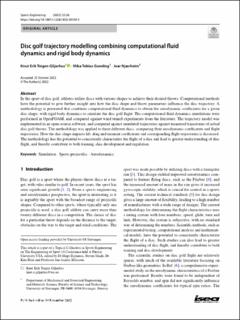| dc.contributor.author | Giljarhus, Knut Erik Teigen | |
| dc.contributor.author | Gooding, Mika Tobias | |
| dc.contributor.author | Njærheim, Joar | |
| dc.date.accessioned | 2022-12-30T13:59:09Z | |
| dc.date.available | 2022-12-30T13:59:09Z | |
| dc.date.created | 2022-11-28T15:44:21Z | |
| dc.date.issued | 2022 | |
| dc.identifier.citation | Giljarhus, K. E. T., Gooding, M. T., & Njærheim, J. (2022). Disc golf trajectory modelling combining computational fluid dynamics and rigid body dynamics. Sports Engineering, 25(1), 1-9. | en_US |
| dc.identifier.issn | 1369-7072 | |
| dc.identifier.uri | https://hdl.handle.net/11250/3040111 | |
| dc.description.abstract | In the sport of disc golf, athletes utilize discs with various shapes to achieve their desired throws. Computational methods have the potential to give further insight into how the disc shape and throw parameters influence the disc trajectory. A methodology is presented that combines computational fluid dynamics to obtain the aerodynamic coefficients for a given disc shape, with rigid body dynamics to simulate the disc golf flight. The computational fluid dynamics simulations were performed in OpenFOAM, and compared against wind tunnel experiments from the literature. The trajectory model was implemented in an open-source software, and compared against simulated trajectories against measured trajectories of actual disc golf throws. The methodology was applied to three different discs, comparing their aerodynamic coefficients and flight trajectories. How the disc shape impacts lift, drag and moment coefficients and corresponding flight trajectories is discussed. The methodology has the potential to consistently characterize the flight of a disc and lead to greater understanding of disc flight, and thereby contribute to both training, disc development and regulation. | en_US |
| dc.language.iso | eng | en_US |
| dc.publisher | Springer Nature | en_US |
| dc.rights | Navngivelse 4.0 Internasjonal | * |
| dc.rights.uri | http://creativecommons.org/licenses/by/4.0/deed.no | * |
| dc.title | Disc golf trajectory modelling combining computational fluid dynamics and rigid body dynamics | en_US |
| dc.title.alternative | Disc golf trajectory modelling combining computational fluid dynamics and rigid body dynamics | en_US |
| dc.type | Peer reviewed | en_US |
| dc.type | Journal article | en_US |
| dc.description.version | publishedVersion | en_US |
| dc.rights.holder | The author | en_US |
| dc.subject.nsi | VDP::Matematikk og Naturvitenskap: 400 | en_US |
| dc.source.volume | 25 | en_US |
| dc.source.journal | Sports Engineering | en_US |
| dc.source.issue | 1 | en_US |
| dc.identifier.doi | 10.1007/s12283-022-00390-5 | |
| dc.identifier.cristin | 2082997 | |
| cristin.ispublished | true | |
| cristin.fulltext | original | |
| cristin.qualitycode | 1 | |

